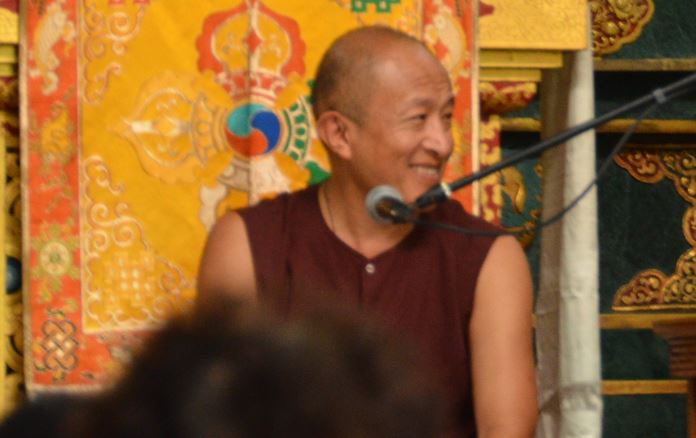A common teaching in Tibetan Buddhism suggests that, “if a lama or rinpoche says something wrong, you MUST point it out as wrong.” They might be pure beings, perfect Buddha’s etc, but right there, right then, they were, “manifesting an opportunity for you to correct them.” This and similar teachings permeate the Buddhist tradition, which is built upon harmonious behavior, careful instruction, reflection, reason, and debate.

With that in mind I point at a few things in Dzongsar Khyentse Rinpoche’s recent statement about Sogyal and Vajrayana Buddhism that seem wrong to me. (First, if you haven’t already, go read the statement in full, as per his wishes.)
Can’t trust journalists or ‘Buddhist’ magazines
Dzongsar Khyentse begins by writing that:
Unfortunately, journalists always cut up texts, then pick and choose the bits and pieces that fit in with their own preconceived ideas. If you don’t believe me, just spend five minutes looking at CNN, Fox News, al-Jazeera, The New York Times, The Guardian newspaper or Breitbart News Network. You’ll soon see what the nature of ‘freedom of speech’ is like in our modern society.
Starting off with a broadside against journalists? Worked for Trump, I guess. In my experience, journalists are imperfect but mostly trying to report truth; though I wouldn’t necessarily put Fox/Breitbart in the same category as the rest in this regard. He continues:
Sadly, most ‘Buddhist’ magazines and bulletins are no different.
Classy, putting Buddhist in scare-quotes like that. Come on Tricycle and Lion’s Roar. Are you Buddhist, or are you ‘Buddhist’?
First, though, I feel I must point out that what I want to say concerns the relationship between a guru and a student that is specific to the Vajrayana. As this kind of guru-student relationship is a Vajrayana phenomenon, I wish I could say that if you are not a Vajrayana student, you don’t need to worry or care about any of what follows. But I can’t. Why? Because like it or not, the Vajrayana is associated with Buddhism, and so in the process of addressing a Vajrayana situation, I can’t avoid talking about Buddhism and its future.
Having said that, I’m sure that the Theravada and Mahayana Buddhists who have been dragged into this public debate by mere association, must be pulling their hair out with frustration. I empathize; if I were in your shoes, I would feel the same.
I hope no one is pulling their hair out. That said, it’s probably good for Theravadins and Mahayana Buddhists to be watching this situation, if only to see how to most appropriately deal with sexual predators in their communities. I agree about the particularity of Vajrayana relationships. There can be a very similar closeness of teacher/student in Chan/Zen but the structures are quite different.
But there is one thing we must all be clear about. There is a clear difference between Sogyal Rinpoche’s role as a Vajrayana master and his role as a very public Buddhist teacher and head of a non-profit organization. Vajrayana masters are not necessarily public figures. Many aren’t even known to be Buddhist teachers—in the past, some Vajrayana masters earned their livings as prostitutes and fishermen. But unlike the teacher-student relationship in other traditions, in the Vajrayana, the connection between the guru and the student is sometimes more personal and constant than family.
More often than not, the opposite is true for teachers who present Buddhism more generally. These teachers are often public figures. In many cases, they have many followers, and they and their teachings are widely available. They may also be at the helm of any number of monasteries or non-profit organizations.
An interesting clarification: there is the Vajrayana master Sogyal Rinpoche and the Buddhist teacher Sogyal Rinpoche.
So ‘Vajrayana guru’ and ‘Buddhist teacher’ are, in fact, totally different roles—even when both roles are fulfilled by one person. What I want to discuss here is the role of Vajrayana master generally and Sogyal Rinpoche’s role as Vajrayana master in particular, not Sogyal Rinpoche’s role as spiritual director of Rigpa and public Buddhist teacher.
This distinction is important because many Buddhists students are wondering how to explain this kind of scandal to their friends and loved ones. How can you talk about it with your little sister who goes to a Christian high school? Or to your new non-Buddhist boyfriend, who you really want to impress but who already thinks your eagerness to do anything this guru asks of you is really strange. So this is an issue that should be contemplated and addressed separately, especially in light of the increased media coverage Sogyal Rinpoche’s behaviour is bound to elicit.
None of what I have to say here about the Vajrayana in particular is easy to explain. In fact, I am a bit concerned that I might end up raising more questions than answers. And I’m also sure that my words will be misinterpreted. But I have decided to try to write this piece anyway, because there are many genuine Vajrayana practitioners out there who are struggling with how to view the present situation and who might want to consider the issues I wish to raise.
Tilopa, Trungpa, and Crazy Wisdom
Fair enough. Dzongsar then recounts the story of Naropa and Tilopa and their lineage right down to Chogyam Trungpa, concluding of Trungpa’s students:
By the way, if you’re ever surrounded by a few of these practitioners, they’ll talk about the glories of Trungpa Rinpoche until your ears fall off!
Some will. Others left the community for various reasons. You can read for yourself in the ‘controversies’ section of Trungpa’s wikipedia page or elsewhere. A book mentioned there is reviewed thusly:
I found especially interesting the dynamics between the Tibetan lama, Trungpa Rinpoche, and his American students, all brimming with devotion and lacking in personal authority, and the parallel with dysfunctional family systems. Trungpa Rinpoche appears as a drunken, crazy surrogate for the dysfunctional families of the authors. The ploys used to keep the power differential operating in the community of Rinpoche’s followers mimic the betrayal and required secrets in the alcoholic family.
This isn’t to say that Trungpa’s antics weren’t also enlightened play or perfect actions simply mis-perceived by some. But it is fair to say that Trungpa’s reception was mixed. Regarding the Tilopa story, Buddhist teacher and translator of Tibetan texts Malcolm Smith writes:
Oh, and BTW, bringing up Naropa and Tilopa, etc. is bullshit. Please stop doing it. The twelve trials are just stories, didactic stories to show what a huge egotist Naropa was. They doubtless have some basis, but they are exaggerated way beyond anything anyone can reasonably accept as anything other than Indian/Tibetan dramatic hyperbole.
Back to Dzongsar. He asks:
“Did Sogyal Rinpoche Do ‘Wrong’?
Again, clever scare-quotes. What is ‘wrong‘ anyway? Luckily, those of us in the Buddhist tradition have plenty of resources for this, right up to and including the wonderful Dalai Lama who has already answered this question with an unequivocal YES. But Dzongsar disagrees.
Recently, it was alleged by some of Sogyal Rinpoche’s students, who also consider themselves to be practitioners in the Vajrayana tradition, that Sogyal Rinpoche regarded abusive behaviour as the ‘skilful means’ of ‘wrathful compassion’ in the tradition of ‘crazy wisdom.’
However you describe Sogyal Rinpoche’s style of teaching, the key point here is that if his students had received a Vajrayana initiation, if at the time they received it they were fully aware that it was a Vajrayana initiation, and if Sogyal Rinpoche had made sure that all the necessary prerequisites has been adhered to and fulfilled, then from the Vajrayana point of view, there is nothing wrong with Sogyal Rinpoche’s subsequent actions. (By the way, ‘initiation’ includes the pointing out instruction which is the highest Vajrayana initiation, known as the fourth abhisheka.)
That’s a lot of ifs. And to be clear, you can read the full letter regarding Sogyal’s actions here. You can also read an excellent account by Michaela Haas here.
Frankly, for a student of Sogyal Rinpoche who has consciously received abhisheka and therefore entered or stepped onto the Vajrayana path, to think of labelling Sogyal Rinpoche’s actions as ‘abusive,’ or to criticize a Vajrayana master even privately, let alone publicly and in print, or simply to reveal that such methods exist, is a breakage of samaya.
The students write, “You have punched and kicked us, pulled hair, torn ears, as well as hit us and others with various objects such as your back-scratcher, wooden hangers, phones, cups, and any other objects that happened to be close at hand.” If samaya requires students to put up with this without calling it what it is, well, as the kids say, “f*ck samaya.”
This is not to say, as has been suggested, that tantra provides teachers with a list of ways they can abuse students sexually, emotionally and financially—you will not find such a list in any of the tantras. At the same time, a Vajrayana guru will use anything he can to challenge and go against each individual student’s ego, pride, self-cherishing and dualistic mind, and might well end up telling a sexually voracious, horny man to become a monk.
Yea, that’s going to go well.
I’m sorry, but we can’t bend the rules on this point. When both the giver and receiver of a Vajrayana initiation are fully aware and clear about what has happened, they must then both accept that pure perception is the main view and practice on the Vajrayana path. There is no room whatsoever for even a glimmer of an impure perception.
That’s not what the Dalai Lama said. I think I’m going with the Dalai Lama on this one.
Can there be merit in pointing out abuse?
Dzongsar goes on to explain pure perception
So if a student of Sogyal Rinpoche were to see him floundering in the middle of a lake and based on their impure perception, project onto him the idea that he seems to be drowning, it would probably not be a good idea for that student to think, “Rinpoche is an enlightened being and should be able to walk on water.” A much better thought would be, “This is my impure perception! Rinpoche is manifesting as a drowning man so that I can accumulate the merit of rescuing him.”
Right. So why can’t students accumulate the merit of pointing out his abuse and ending it?
As your practise improves, your perception of the guru will no longer be bound or limited by the causes, conditions and effects that once made you think he was drowning. This is the point in your spiritual development when you will truly see the outer guru as the Buddha and will also be able to see your own inner guru.
As your practice improves and your guru is no longer abusing you and others, you will no longer think he is abusing you or others. It seems that the students who wrote the letter, leading to Sogyal’s retirement, have done just this.
Until then, when your guru chairs a board meeting and it becomes obvious that he has no clue about an issue, as a prudent member of that board you shouldn’t hesitate to supply him with the information he needs. At the same time, as a Vajrayana student, you must skilfully remind yourself the guru only looks clueless to you because of your own impure perception, and that by appearing to need your assistance the guru is actually giving you the chance to accumulate merit.
This is that “Buddhist vs Vajrayana” clarification from above. These students, while writing their letter to Sogyal -the Buddhist teacher- need to keep a pure view of Sogyal -the Vajrayana master. They’re supplying him as the teacher “with the information he needs” – hey, you’re abusive, stop that. But as a Vajrayana master, perhaps they still see him with pure view. Who knows?
We all have habits, and it’s habit that makes impure perception inevitable. The moment we step onto the Vajrayana path, we start breaking ‘samayas’—which are our commitment to maintaining pure perception. This is why the assumption that all Vajrayana practitioners will make mistakes is built into the Vajrayana path. A practitioner’s path is then to immediately confess, expose and fix any impure perceptions the moment they arise, and to continually aspire to make fewer and fewer mistakes.
This includes Sogyal and other abusive lamas, right?
If an impure perception—such as criticism of one’s guru—is made deliberately and consciously, and if it then goes on to become a well-organized, choreographed public discussion with no room for amendment or correction, it constitutes a total breakage of samaya.
Oh, so we can save them from a lake or from making a mistake at a board meeting, but when we call them out for punching and kicking us, we’re breaking samaya due to impure perception. Again, this seems to be the exact opposite of what the Dalai Lama had to say. Dzongsar writes, “Once an initiation has been given and received, neither the guru nor the student can continue to analyze each other.” The Dalai Lama states, ”
You should not say, “oh this is my guru, whatever the guru says I must follow” – that is totally wrong. The Buddha himself mentioned, “my teachings, you must examine.”
Similarly, if one particular lama says something, you examine: whether this go well with the Buddha’s teachings or the circumstances of society, then you must follow.
If the lama says something, and you investigate, is not proper, then you should not follow the lama’s teaching. Even the Dalai Lama’s teaching: if you find some contradiction, then you should not follow: that is my teaching.
Attacking pretty much everyone
Again, Dzongsar hits back:
It’s a big mistake to speculate about the possibility of continuing to analyze and criticize the guru after having received a major initiation—actually it’s totally wrong. We cannot modify Vajrayana’s fundamental view just because it doesn’t suit the minds of a few liberal, puritanical, Abrahamic, or individualistic activists.
He then lashes out against “dualistic” Abrahamic religions. Followed with:
If the label ‘religion’ is altogether too embarrassing for your elitist so-called progressive minds, you might try some kind of quasi-atheistic secularism, coated with moralistic ethics and bloated with dogmatic liberal self-righteousness. Or you could blindly allow yourself to be swallowed up by existentialist angst, then get annoyed with those who get blissed out on hope.
He then goes after “whiney” Vajrayana practitioners as well:
And yet, there may be some among you who long for tantric teachings because you quickly want to gain all the spiritual accomplishments you can, but without suffering any of the pain; or because you’re the kind of person who has a strong sense of entitlement and love to bypass preliminary practices. Or you might be very smart and want to follow the simplest path that gets the quickest results, so you might try outwitting the system by cutting corners to get at the highest Dzogchen and Mahamudra teachings more quickly. Or you might be one of those who whine bitterly when the guru says it’s not the right time to give such teachings and then apply intense emotional blackmail to get what you want. If you fall into any of these categories, the all-or-nothing guru-disciple relationship is what you will get. I’m sorry, but that’s the way it is and there’s nothing I can do about it.
We can’t change the Vajrayana view or invent some ‘moderate’ version of Vajrayana Buddhism just to suit the 21st century Western mind-set. If we did, it would be like saying that in these modern times, we should say that certain compounded phenomena are permanent and some phenomena do exist inherently—but we can’t do that either. The view is fundamental to Buddhadharma and therefore to the Vajrayana path.
All of this is fair to some degree but seems misplaced in this discussion. Dzongsar continues with a good description of spiritual growth in Vajrayana, which again is good (except for the unquestioning devotion he suggests one has to have toward a teacher – again, the opposite of what the Dalai Lama teaches).
Dzongsar, in another strange twist, goes on to suggest that Sogyal wasn’t really a very good teacher to begin with and perhaps didn’t adequately warn his students.
If Sogyal Rinpoche had given these warnings, if he had laid proper foundations by teaching the fundamentals of Buddhism, if he had made sure his students had established a strong foundation through study and practice, and if he had told them before they received initiation and teaching about the nature of the Vajrayana path and the consequences they would face if they broke samaya, the chances are that this current situation would never have arisen.
Again, those ifs, here suggesting that Sogyal didn’t. Something he writes next is again quite strange:
More than two millennia before the downfall of authoritarianism in the West, the Buddha taught, “You are your own master. No one else is your master.” Neither of these pieces of advice has ever been taken seriously in Tibet. Not taking such teachings seriously is a very bad habit and certainly nothing to be proud of.
It seems that he’s criticizing the whole master-disciple relationship he was just saying “is the way it is.” And he says this is a very bad habit of those in Tibet.
So nowadays, when Tibetan lamas apply their habit of openly giving Vajrayana teachings to non-Tibetans—particularly Westerners—but forget that they are presenting these disciplines to people who read The New York Times, are groomed in critical thinking, trained to cherish analysis and contemplation, and applauded for rebelling against convention, isn’t it inevitable that things fall apart?
He really doesn’t like The New York Times, does he? So critical thinking and analysis are part of the problem?
They were Christians one day, initiates the next
Dzongsar then tells us that he’s seen the “Rigpa set-up first hand:”
I know a little about Sogyal Rinpoche because I have visited several Rigpa centres and have witnessed the Rigpa set-up first hand. To be frank, I didn’t see enough evidence to convince me that the appropriate warnings had been given, or that adequate foundations had been laid, or that the fundamental teachings were properly given. On several occasions it seemed to me that some of the students had been Christians until perhaps the day before they attended the teaching, then suddenly, 24 hours later, they were hearing about guru devotion, receiving pointing out instructions and practising Guru Yoga—it was as extreme as that.
If that’s how it happened—if no proper warnings and no fundamental training were given prior to the Vajrayana teachings—then Sogyal Rinpoche is even more in the wrong than his critical students. Why? Because it is his responsibility to prepare the ground in accordance with the Vajrayana’s prescribed and well-established foundation teachings and practice. There is no question that the person with the greater knowledge, power and therefore responsibility is also more culpable when those obligations are not fulfilled.
This is as close as we’ve come to recognizing that Sogyal might have done something wrong here. But why did Dzongsar never say anything about this problematic situation?
Blaming the Victims
The next bit is what makes my Irish blood boil just a little bit, he puts the victimized students on trial.
But there are things about all this that puzzle me. The students criticizing Sogyal Rinpoche seem to be highly intelligent. Why, then, weren’t they smart enough to examine and analyze the teacher before signing up? How did they allow themselves to get so carried away by the Rigpa experience, those glossy, well-crafted pamphlets and all the other hoo-ha? And I really don’t understand why they waited ten or even thirty years before saying anything? How come they didn’t see all these problems in the first or second year of their relationship with Sogyal Rinpoche?
I should also say that my puzzlement is mixed with sympathy, because we human beings are not only subject to our intellects, we get stirred up by our feelings. I can only speculate, but perhaps these students were moved and even awed by everything they encountered at Rigpa? Perhaps the glossy pamphlets, the incense, thrones and chanting did their job? And of course, Rigpa has hosted many very highly respected, illustrious lamas, including the highest of them all, which must have cemented the veneration and respect these students felt not only for the whole tradition, but for Sogyal Rinpoche himself. As a result of the unexpected eruption of pious feelings they then experienced, there must have been very little room left in their minds for further analysis, because emotionally they just wanted to ‘jump!’ From what I have seen in Rigpa, this may well have been what happened.
So we blame the victims and then we blame the “glossy pamphlets, the incense, thrones and chanting” that deceived them and took away their intellects by stirring up feelings.
Alas, karma does also seem to play a role in all this, doesn’t it? And now that I’ve brought up karma, I’m sure some of you will accuse me falling back on another cop-out. Nevertheless, the reality is that falling for glossy advertising and Tibetan paraphernalia, feeling inspired and touched by Tibetan exoticism and the endangered Tibetan species, and everything else that pops into our minds, all arise from the causes and conditions that are the essence of karma.
That’s the way it is and all I can do is encourage each one of us to accumulate more good karma so that we won’t be faced with this kind of situation again in our lifetimes. Feelings are karmic. And I am afraid this situation won’t be settled until that karma is exhausted.
Oh, karma. How nice. It’s like we can use this lofty spiritual talk to just go right around the very mundane, moralistic, dualistic ethics that other people want to push. Hmmm, using spirituality to bypass ethics, if only there were a word or phrase for that.
He then gives a long sermon on how hard it is to be a guru and the horrible hells they go to if they screw up. There he gives a very good section on simply being a decent person as a teacher. Next he makes the claim, that “I would say that only one lama has really understood Western culture and acted on it appropriately, Chogyam Trungpa Rinpoche.”
What about the Dalai Lama?
Perhaps he is thinking more of those who have settled in the West. He criticizes other lamas for emphasizing too much culture and not enough dharma and lays some blame on Western students, “who are sometimes more interested in looking and speaking like Tibetans than actually practising the Dharma.”
It’s those other guys
In a section on checks and balances, Dzongsar almost seems to praise those who would call out abusive lamas. But then suggests that, “the few decent human beings left on this planet are disappearing fast. Perhaps exposing people’s faults publicly like this, in social media and elsewhere, will make others afraid to act badly?” But then he says no, “But I really don’t believe that public shaming or legal punishment is the answer, or that it will actually solve the whole problem.” Again, the opposite of what the Dalai Lama has said.
He then goes on to change the topic to other things he sees as harming Buddhism: “Under the banner of rational objectivity as opposed to superstition, and clothed in a supposedly undogmatic liberalism, many among the European and American Buddhist elite are currently promoting a version of Buddhism that completely does away with reincarnation. Their campaign has the potential to destroy Buddhism far more surely than any of its internal scandals.”
And then there are the “‘respectable’ life-style teachers” and “self-made gurus who use mindfulness and other Buddhist practices to turn the essence of the Buddhist path into techniques for increasing our love of samsara.” He also suggests that there are those at the other extreme who, “the process of trying to embalm their traditions, are effectively hijacking Buddhism and stripping it of all meaning and relevance for this modern age.”
Again I’d say there is fairness in critiquing those who water down Buddhism too much as well as those who hold rigidly to the past. Most Buddhists work to be in the middle ground here and are well aware of the difficulty. I’ll point out one who I think has been particularly good in this: the Dalai Lama (I might have mentioned him already once or twice here).
Sogyal Rinpoche’s misbehaviour may be his ruin and, sadly, it may be the ruin of some of his students. But the other far more destructive trends within Buddhadharma have the power to affect millions and will ultimately destroy Buddhism far more completely than this present scandal. Frankly, they are even more deadly than the decimation wreaked on Buddhadharma by the Cultural Revolution and other external forces.
Well, first we have to point out that here, at last, Dzongsar has pointed to “Sogyal Rinpoche’s misbehaviour.” But, in the same paragraph he points much greater blame at everyone else with about as much hyperbole as one could imagine.
What Now?
Dzongsar concludes the essay, in part, by once again diverting attention from the particular matter at hand, “I think that this particular situation is giving us all the opportunity to show how resilient we are. It’s also our chance to think about Buddhism’s big picture rather than just one small corner.”
But then again he seems to praise the students who raised the abuse claims (and even the ‘Buddhist’ magazines and others who have been following the Dalai Lama’s advice to publicize the matter):
For followers of the Buddha, particularly Vajrayana students and especially students of Sogyal Rinpoche and those who are asking very hard questions, I firmly believe that the current discussion about how gurus behave is rooted in a sincere desire to sort things out and to help the Rigpa sangha and larger Buddhist world. This is the positive aspect of the kind of questioning we are seeing today, and it’s an aspect that really must be recognized and appreciated.
Like it or not, as members of the wider Buddhist sangha and specifically as vajra brothers and sisters, we have created a bond between us that is far more important than family. But in our close relationships, we human beings often suffer as a result of miscommunication. What is the antidote for miscommunication? Communication! So now’s the time to clear a space in which genuine, wholehearted communication can take place. In fact, I’ve already seen a number of letters and on-line postings by people who are making a big effort to find a good solution.
He goes on to say that, “On balance, I would argue that Sogyal Rinpoche has contributed far more benefit to this world and Buddhadharma than harm.” That’s nice. And probably true. But it is also a deflection from the matter at hand. We can think of several pretty good folks who turned out to be also criminals, Bill Cosby being a recent one. On balance, his show and humor were great. But he should still, on balance, be in jail for what he did to a number of women. It’s a bit too soon to jump to letting the famous man off the hook for his wrongdoings.
He then gives some strange praise of Rigpa students (who he had earlier accused of being duped by the glossy pamphlets and incense) and then just flails with this quick attack, “I suspect that many liberals, atheists and much of the Western media would be delighted if news of a Jain suicide bomber now hit the headlines, because it would prove their point that all religions have a dark side and harbour extremists.”
Buddhists have it worse than Muslims?
How can we not be discouraged when Germany’s largest daily newspaper, the Süddeutsche Zeitung with a daily readership of more than one million, publishes a lead article about the Sogyal Rinpoche scandal under the section heading ‘Buddhism,’ and entitled “Abuse.” Imagine the outcry if the Western press were to report every Muslim bombing and massacre under the heading ‘Islam!’
They do. More or less.
It is a well-discussed fact that in the last 30 years Buddhists have had the pleasure of an abundance of good press while Muslims have suffered unfairly in the public eye. To suggest otherwise gets my blood boiling a tiny bit once more. (A re-cap, two things that will upset Justin are: 1) Victim blaming and 2) suggesting that Buddhists have a harder time in the media than Muslims.)
Dzongsar closes with one last swipe – this one at “liberal intellectuals” (hi), “In an era when wrong views and murderous actions not only prevail, but are celebrated and even justified by respected liberal intellectuals, we must redouble our efforts to study the authentic view of Buddhadharma.”
Yes, that’s what we liberal intellectuals are doing when we’re not corrupting the youth, we’re out celebrating murderous actions. Sigh.
Oh, another thing that liberal intellectuals are up to is investigating abuse by people in power, including Buddhist organizations. As Michaela Haas reports: “the problem is far bigger than Rigpa. Rob Hogendoorn is currently investigating abuse allegations against the male leaders of 19 out of the 39 registered Buddhist organisations in Holland.” Read more about Hogendoorn’s work here.
Conclusion on Pure View
There are various ways we can read Dzongsar Khyentse Rinpoche’s 10,000 word article. Perhaps it was a reactive defense of a sexual predator, with a mix of victim-blaming and diverting attention to other problems. But perhaps it was a skillful way to get more people to closely examine the abuse by Sogyal and to talk about potential abuses elsewhere. Perhaps Dzongsar really does want more attention on this topic and his attacks on journalists and liberal intellectuals were skillful means toward getting us to revisit this case once more.
After all, Dzongsar Khyentse has spoken passionately and eloquently about the need to change the outdated tulku system, and also about why homosexuality should be respected by Buddhists. Surely he has a similar, enlightened mindset regarding abusive gurus and his seemingly outlandish comments above should not be read at face value.
Support independent coverage of Buddhism by joining a community of fellow learners/practitioners at Patreon.
‘Like’ American Buddhist Perspectives on facebook.












